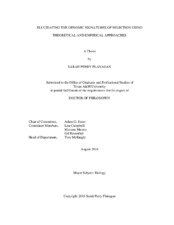| dc.contributor.advisor | Jones, Adam G | |
| dc.creator | Flanagan, Sarah Perry | |
| dc.date.accessioned | 2016-09-22T19:41:27Z | |
| dc.date.available | 2018-08-01T05:57:28Z | |
| dc.date.created | 2016-08 | |
| dc.date.issued | 2016-06-02 | |
| dc.date.submitted | August 2016 | |
| dc.identifier.uri | https://hdl.handle.net/1969.1/157968 | |
| dc.description.abstract | Selection acts on phenotypes, but it is important to understand how its effects on the genome result in evolutionary change. Population genomics has provided several methods for detecting the form of selection acting on populations (e.g. positive or balancing), but current techniques are limited in their ability to identify the type of selection acting on traits (e.g. natural or sexual). Selection components analysis detects the types of selection acting in a population by comparing allele frequencies at different life history stages. In my dissertation, I used both population genomics analyses and selection components analysis to identify signatures of selection in natural populations.
I first conducted a traditional population genomics study to determine the population structure of multiple populations throughout the Gulf of Mexico and Atlantic Ocean in Gulf pipefish (Syngnathus scovelli). I also identified genome-wide loci that were differentiated between populations due to local adaptation. Although the results suggest that population divergence is driven by a variety of factors in S. scovelli, including neutral processes and selection on multiple traits, this population genetics approach could not differentiate among sexual or natural selective processes.
Next, I developed an individual-based simulation model to test the power of a selection components analysis approach with genome-wide data that mimicked next-generation sequencing datasets. The model showed that quantitative trait loci can be identified with relatively high power if selection was strong, sample sizes were large, and there were few loci underlying the trait.
Finally, I implemented the genome-wide selection components analysis in one population of Gulf pipefish and identified loci significantly associated with sexual selection and differential viability selection between males and females. Together, these studies allowed to me identify several signatures of selection at the genomic level in pipefish, which provides a better understanding of the relationship between selection and the genome. The genomic signatures of selection identified here can be integrated with other studies for a better understanding of broad-scale evolutionary patterns at the genomic level. | en |
| dc.format.mimetype | application/pdf | |
| dc.language.iso | en | |
| dc.subject | pipefish | en |
| dc.subject | Syngnthatus scovelli | en |
| dc.subject | population genomics | en |
| dc.subject | selection components analysis | en |
| dc.subject | simulation model | en |
| dc.subject | RAD-seq | en |
| dc.subject | next generation sequencing | en |
| dc.subject | SNPs | en |
| dc.title | Elucidating the Genomic Signatures of Selection Using Theoretical and Empirical Approaches | en |
| dc.type | Thesis | en |
| thesis.degree.department | Biology | en |
| thesis.degree.discipline | Biology | en |
| thesis.degree.grantor | Texas A & M University | en |
| thesis.degree.name | Doctor of Philosophy | en |
| thesis.degree.level | Doctoral | en |
| dc.contributor.committeeMember | Campbell, Lisa | |
| dc.contributor.committeeMember | Mateos, Mariana | |
| dc.contributor.committeeMember | Rosenthal, Gil | |
| dc.type.material | text | en |
| dc.date.updated | 2016-09-22T19:41:27Z | |
| local.embargo.terms | 2018-08-01 | |
| local.etdauthor.orcid | 0000-0002-2226-4213 | |


